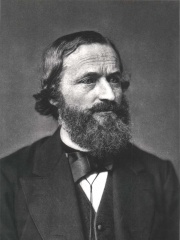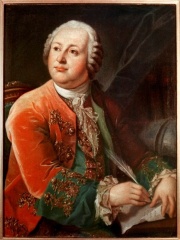







The Most Famous
PHYSICISTS from Russia
This page contains a list of the greatest Russian Physicists. The pantheon dataset contains 851 Physicists, 47 of which were born in Russia. This makes Russia the birth place of the 5th most number of Physicists behind United Kingdom, and France.
Top 10
The following people are considered by Pantheon to be the top 10 most legendary Russian Physicists of all time. This list of famous Russian Physicists is sorted by HPI (Historical Popularity Index), a metric that aggregates information on a biography's online popularity. Visit the rankings page to view the entire list of Russian Physicists.

1. Gustav Kirchhoff (1824 - 1887)
With an HPI of 79.22, Gustav Kirchhoff is the most famous Russian Physicist. His biography has been translated into 85 different languages on wikipedia.
Gustav Robert Kirchhoff (German: [ˈgʊstaːf ˈʁoːbɛʁt ˈkɪʁçhɔf]; 12 March 1824 – 17 October 1887) was a German physicist and mathematician who contributed to the fundamental understanding of electrical circuits, spectroscopy, and the emission of black-body radiation by heated objects. He coined the term black body in 1860. Several different sets of concepts are named "Kirchhoff's laws" after him, which include Kirchhoff's circuit laws, Kirchhoff's law of thermal radiation, Kirchhoff's diffraction formula, and Kirchhoff's law of thermochemistry. The Bunsen–Kirchhoff Award for spectroscopy is named after Kirchhoff and his colleague, Robert Bunsen.

2. Wilhelm Wien (1864 - 1928)
With an HPI of 78.90, Wilhelm Wien is the 2nd most famous Russian Physicist. His biography has been translated into 90 different languages.
Wilhelm Carl Werner Otto Fritz Franz Wien (German: [ˈvɪlhɛlm ˈviːn] ; 13 January 1864 – 30 August 1928) was a German physicist who used theories about heat and electromagnetism to deduce Wien's displacement law, which calculates the emission of a blackbody at any temperature from the emission at any one reference temperature. He also formulated an expression for the black-body radiation, which is correct in the photon-gas limit. His arguments were based on the notion of adiabatic invariance, and were instrumental for the formulation of quantum mechanics. Wien received the Nobel Prize in Physics in 1911 for his work on heat radiation. He was a cousin of Max Wien, inventor of the Wien bridge.

3. Andrei Sakharov (1921 - 1989)
With an HPI of 78.11, Andrei Sakharov is the 3rd most famous Russian Physicist. His biography has been translated into 95 different languages.
Andrei Dmitrievich Sakharov (Russian: Андрей Дмитриевич Сахаров; 21 May 1921 – 14 December 1989) was a Soviet physicist and a Nobel Peace Prize laureate, which he was awarded in 1975 for emphasizing human rights around the world. Although he spent his career in physics in the Soviet program of nuclear weapons, overseeing the development of thermonuclear weapons, Sakharov also did fundamental work in understanding particle physics, magnetism, and physical cosmology. Sakharov is mostly known for his political activism for individual freedom, human rights, civil liberties and reforms in the Soviet Union, for which he was deemed a dissident and faced persecution from the Soviet establishment. In his memory, the Sakharov Prize was established and is awarded annually by the European Parliament for people and organizations dedicated to human rights and freedoms.

4. Mikhail Lomonosov (1711 - 1765)
With an HPI of 75.69, Mikhail Lomonosov is the 4th most famous Russian Physicist. His biography has been translated into 88 different languages.
Mikhail Vasilyevich Lomonosov (; 19 November [O.S. 8 November] 1711 – 15 April [O.S. 4 April] 1765) was a Russian polymath, scientist and writer, who made important contributions to literature, education, and science. Among his discoveries were the atmosphere of Venus and the law of conservation of mass in chemical reactions. His spheres of science were natural science, chemistry, physics, mineralogy, history, art, philology, optical devices and others. The founder of modern geology, Lomonosov was also a poet and influenced the formation of the modern Russian literary language.

5. Arnold Sommerfeld (1868 - 1951)
With an HPI of 75.11, Arnold Sommerfeld is the 5th most famous Russian Physicist. His biography has been translated into 65 different languages.
Arnold Johannes Wilhelm Sommerfeld (German: [ˈaʁnɔlt ˈzɔmɐˌfɛlt]; 5 December 1868 – 26 April 1951) was a German theoretical physicist who pioneered developments in both atomic and quantum physics, and also educated and mentored many students for the new era of theoretical physics. Sommerfeld served as doctoral advisor and postdoctoral advisor to seven Nobel Prize winners and supervised at least 30 other famous physicists and chemists. Sommerfeld introduced the second quantum number, azimuthal quantum number, and the third quantum number, magnetic quantum number. He also introduced the fine-structure constant and pioneered X-ray wave theory.

6. Pavel Cherenkov (1904 - 1990)
With an HPI of 74.18, Pavel Cherenkov is the 6th most famous Russian Physicist. His biography has been translated into 77 different languages.
Pavel Alekseyevich Cherenkov (Russian: Па́вел Алексе́евич Черенко́в [ˈpavʲɪl ɐlʲɪkˈsʲe(j)ɪvʲɪtɕ tɕɪrʲɪnˈkof]; 28 July 1904 – 6 January 1990) was a Soviet physicist who shared the 1958 Nobel Prize in Physics with Ilya Frank and Igor Tamm "for the discovery and interpretation of the Cherenkov effect".

7. Ilya Frank (1908 - 1990)
With an HPI of 72.03, Ilya Frank is the 7th most famous Russian Physicist. His biography has been translated into 70 different languages.
Ilya Mikhailovich Frank (Russian: Илья Михайлович Франк; 23 October 1908 – 22 June 1990) was a Soviet physicist who received the 1958 Nobel Prize in Physics, jointly with Pavel Alekseyevich Cherenkov and Igor Y. Tamm, also of the Soviet Union. He received the award for his work in explaining the phenomenon of Cherenkov radiation. He received the Stalin prize in 1946 and 1953 and the USSR state prize in 1971.

8. Igor Tamm (1895 - 1971)
With an HPI of 71.97, Igor Tamm is the 8th most famous Russian Physicist. His biography has been translated into 76 different languages.
Igor Yevgenyevich Tamm (Russian: И́горь Евге́ньевич Тамм; 8 July 1895 – 12 April 1971) was a Soviet physicist who received the 1958 Nobel Prize in Physics, jointly with Pavel Alekseyevich Cherenkov and Ilya Mikhailovich Frank, for their 1934 discovery and demonstration of Cherenkov radiation. He also predicted the quasi-particle of sound: the phonon; and in 1951, together with Andrei Sakharov, proposed the Tokamak system.

9. Alexei Alexeyevich Abrikosov (1928 - 2017)
With an HPI of 71.73, Alexei Alexeyevich Abrikosov is the 9th most famous Russian Physicist. His biography has been translated into 78 different languages.
Alexei Alexeyevich Abrikosov (Russian: Алексе́й Алексе́евич Абрико́сов; June 25, 1928 – March 29, 2017) was a Soviet, Russian and American theoretical physicist whose main contributions are in the field of condensed matter physics. He was the co-recipient of the 2003 Nobel Prize in Physics, with Vitaly Ginzburg and Anthony James Leggett, for theories about how matter can behave at extremely low temperatures.

10. Pyotr Kapitsa (1894 - 1984)
With an HPI of 71.40, Pyotr Kapitsa is the 10th most famous Russian Physicist. His biography has been translated into 82 different languages.
Pyotr Leonidovich Kapitsa or Peter Kapitza (Russian: Пётр Леонидович Капица, Romanian: Petre Capița; 9 July [O.S. 26 June] 1894 – 8 April 1984) was a leading Soviet Russian physicist and Nobel laureate, whose research focused on low-temperature physics.
People
Pantheon has 47 people classified as Russian physicists born between 1711 and 1974. Of these 47, 9 (19.15%) of them are still alive today. The most famous living Russian physicists include Yuri Oganessian, Andre Geim, and Alexey Ekimov. The most famous deceased Russian physicists include Gustav Kirchhoff, Wilhelm Wien, and Andrei Sakharov.
Living Russian Physicists
Go to all RankingsYuri Oganessian
1933 - Present
HPI: 67.54
Andre Geim
1958 - Present
HPI: 67.32
Alexey Ekimov
1945 - Present
HPI: 66.75
Anatoli Bugorski
1942 - Present
HPI: 62.23
Andrei Linde
1948 - Present
HPI: 60.91
George Zweig
1937 - Present
HPI: 60.03
Konstantin Novoselov
1974 - Present
HPI: 59.71
Alexander Markovich Polyakov
1945 - Present
HPI: 55.91
Roald Sagdeev
1932 - Present
HPI: 53.96
Deceased Russian Physicists
Go to all RankingsGustav Kirchhoff
1824 - 1887
HPI: 79.22
Wilhelm Wien
1864 - 1928
HPI: 78.90
Andrei Sakharov
1921 - 1989
HPI: 78.11
Mikhail Lomonosov
1711 - 1765
HPI: 75.69
Arnold Sommerfeld
1868 - 1951
HPI: 75.11
Pavel Cherenkov
1904 - 1990
HPI: 74.18
Ilya Frank
1908 - 1990
HPI: 72.03
Igor Tamm
1895 - 1971
HPI: 71.97
Alexei Alexeyevich Abrikosov
1928 - 2017
HPI: 71.73
Pyotr Kapitsa
1894 - 1984
HPI: 71.40
Vitaly Ginzburg
1916 - 2009
HPI: 70.47
Nikolay Basov
1922 - 2001
HPI: 70.38
Overlapping Lives
Which Physicists were alive at the same time? This visualization shows the lifespans of the 25 most globally memorable Physicists since 1700.












